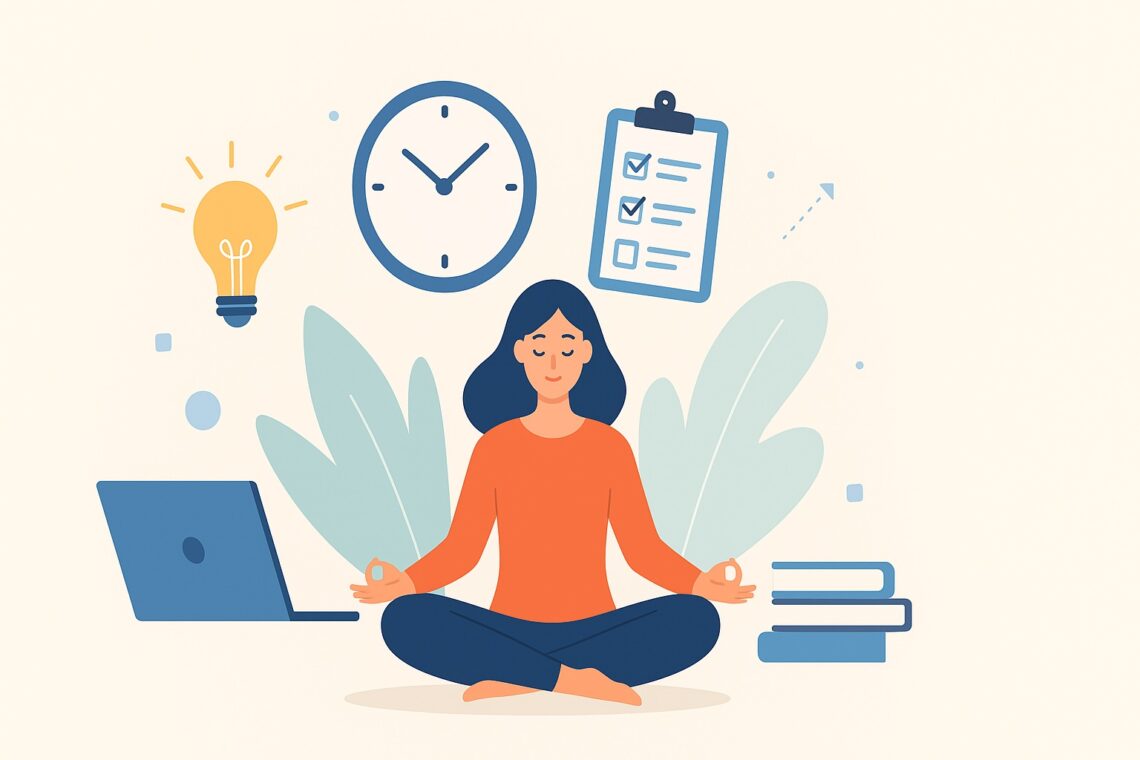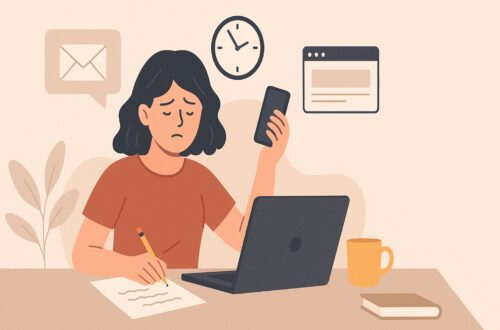We live in a culture that confuses movement with progress. The faster we go, the more productive we think we are—until exhaustion reminds us that speed isn’t the same as success.
What once was meant to empower us has turned into a treadmill of alerts, messages, and endless multitasking. We keep running, but rarely arrive.
A quiet shift, however, is happening among thoughtful creators, leaders, and doers. They’re no longer chasing productivity as a badge of honor. They’re redefining it through a new lens—Mindful Productivity: Doing Less but Achieving More.
This isn’t about meditation timers or perfectly organized planners. It’s about reshaping how we work, think, and recover so that our attention—not our activity—becomes the real measure of progress.
In a world that celebrates busyness, Mindful Productivity: Doing Less but Achieving More celebrates awareness. It’s a philosophy rooted in intentional action—where doing fewer things with clarity creates deeper results.
It doesn’t glorify stillness for aesthetic value, nor reject ambition. Instead, it reimagines our relationship with time, energy, and focus. It’s not about working harder or even smarter—it’s about working presently.
Because true productivity isn’t measured by output, but by awareness. When your attention is scattered, even small tasks feel heavy. But when your mind is calm and centered, you enter a flow where effort feels natural and results unfold with ease.
If this idea speaks to you, explore more about living with conscious intention in our Mindful Living guide.
Let’s unpack how doing less can actually unlock more: more focus, more creativity, and more satisfaction.
The paradox of modern work
We glorify multitasking and treat rest like a luxury. Yet cognitive science shows that humans are terrible at context switching. Every interruption steals mental energy and leaves behind attention residue. The more we chase efficiency, the more we dilute it.
Mindful Productivity: Doing Less but Achieving More begins with an uncomfortable truth: time is not our limiting resource; attention is. You don’t need more hours. You need more clarity, better energy allocation, and fewer distractions disguised as “opportunities.”
Imagine productivity not as a race to the finish line, but as an intentional dance between focus and renewal. The goal is not to do everything faster but to do the right things deeply.
The three pillars of mindful productivity
To master Mindful Productivity: Doing Less but Achieving More, think in systems, not sprints. The framework rests on three interlocking pillars: intention, design, and recovery.
Intention: focus on the few that matter
Mindful productivity starts with radical clarity. Every day, pick two priorities; no more. Write them down with clear outcomes. “Finish presentation” is vague. “Complete and submit presentation draft for client feedback by 4pm” is concrete.
Limiting your daily targets reduces mental clutter. It sharpens the brain’s natural filtering system, allowing you to enter flow states faster. When you choose less, your mind can give more.
Action tip: Before bed, list tomorrow’s top two priorities. When you wake up, revisit them as your compass points for the day. Everything else is noise.
Design: build environments that work for you
Mindful productivity thrives in structured simplicity. You can’t rely on willpower—it depletes quickly. Instead, design your environment so focus happens by default.
-
Time-block your deep work. Protect two 90-minute sessions daily for your most critical task. Treat them like sacred appointments.
-
Use micro-transitions. Start each session with a ritual: close tabs, breathe, stretch. It’s a signal to the brain—“we’re entering focus mode.”
-
Declutter your digital space. Fewer apps, cleaner desktop, and curated notifications all mean fewer decision leaks.
-
Simplify tools. Choose one primary system for notes, one for task management, and one for communication. Anything more creates chaos disguised as organization.
By removing friction, you make presence effortless. Design becomes discipline.
Recovery: rest like it’s a skill
Most people think productivity happens during action. Professionals know it’s also built during rest. Cognitive performance follows the same rules as physical training: growth occurs in recovery.
-
Take micro-rests. Every 60 to 90 minutes, pause. Stand, stretch, breathe, or walk. These short resets restore neural efficiency.
-
Protect sleep. Sleep debt is a tax on every domain—memory, focus, decision-making, creativity.
-
Practice active recovery. Replace passive scrolling with light reading, music, or nature walks. These reset dopamine and improve attention regulation.
-
Set hard boundaries. Define when work stops. Let the day end before you do.
Recovery is not retreat. It’s reinforcement. When you rest deliberately, your work sharpens naturally.
The art of subtraction
Doing less feels uncomfortable at first. We’re conditioned to equate value with volume. But subtraction often reveals what truly matters.
Ask yourself:
-
What tasks move the needle most?
-
Which ones only make me feel productive?
-
What could I stop doing entirely without real loss?
Mindful productivity is subtraction in service of clarity. Each removed distraction creates space for higher-quality effort. Each simplified process frees creative energy.
Remember: effectiveness is not about addition—it’s about precision.
The science behind it
Neuroscientists have mapped how multitasking drains the prefrontal cortex—the part of the brain responsible for executive control. Every switch between tasks demands up to 20 minutes for full reorientation. In contrast, sustained focus increases myelin formation around neural pathways, effectively making your brain faster.
By embracing Mindful Productivity: Doing Less but Achieving More, you optimize for quality attention. This biological alignment is what allows you to perform at a higher level while working fewer hours. It’s not magic—it’s neuroeconomics in action.
Real-world applications
For creators
Creative work thrives on space and silence. Schedule “white space” in your day—periods where you do nothing but think. Great ideas often emerge from stillness, not speed.
For entrepreneurs
Apply mindful productivity to meetings. If a meeting doesn’t have a clear agenda, cancel it. Replace updates with asynchronous written check-ins. You’ll reclaim hours weekly.
For teams
Set collective focus blocks—periods where everyone is unreachable except for emergencies. The shared discipline builds cultural respect for deep work.
For individuals
Mindful productivity begins with awareness. Notice your energy rhythms—your personal high-performance windows. Align your hardest tasks with your natural peaks, not arbitrary clocks.
The invisible ROI of mindfulness
The greatest return of mindful productivity is not just efficiency—it’s presence. When you work deliberately, you also live deliberately.
That means fewer reactive decisions, more creative insights, and a deeper sense of control. You end the day not depleted but fulfilled. That shift ripples outward—into relationships, health, and happiness.
Busyness blurs life. Mindful productivity brings it into focus.
Experiment: your seven-day reset
Try this one-week experiment to prove the concept.
-
Choose only two priorities each day.
-
Block two deep work sessions of 90 minutes each.
-
Before each session, perform a two-minute focus ritual.
-
Take micro-breaks between sessions.
-
End your day with a hard stop—no late-night work.
At the end of the week, review results. You’ll likely find that output quality rises while effort feels lighter. That’s Mindful Productivity: Doing Less but Achieving More at work—less friction, more flow.
From Doing More to Being More
This isn’t just about optimizing work. It’s about redefining success.
Modern productivity often disguises itself as an endless chase—more goals, more output, more hustle. Yet the more we chase, the further we drift from meaning. Mindful productivity invites you to pause and ask a radical question: What if progress isn’t something to chase, but something to embody?
When you practice Mindful Productivity: Doing Less but Achieving More, you stop running toward success and start operating from it. You begin to act from a centered place rather than a restless one. Progress becomes less about checking boxes and more about aligning your energy with purpose.
You shift from managing time—a finite, external metric—to mastering energy, the internal force that fuels everything you create. Time management asks, “How do I fit it all in?” Energy mastery asks, “What deserves my best attention right now?” That single shift changes everything.
Because when energy is high and intention is clear, one well-executed task can outperform a dozen rushed ones. You discover that the secret to sustainable achievement isn’t speed—it’s synchronization between your mind, body, and mission.
You trade overwhelm for focus. You replace exhaustion with clarity. You stop juggling and start channeling.
Doing less is not laziness—it’s leverage.
Laziness is apathy; leverage is wisdom. Doing less strategically means concentrating effort where it matters most. It’s recognizing that the world doesn’t reward the busiest—it rewards the most effective.
When you stop scattering your attention across dozens of half-meaningful tasks, your best work finally gets the oxygen it needs. Doing less gives your ideas depth. It gives your projects polish. It gives you breathing room to think, reflect, and refine.
Minimal effort does not mean minimal impact. It means maximum precision.
Achieving more is not a sprint—it’s alignment.
The myth of the sprint suggests that success is a race against others. Alignment reveals that it’s a dance within yourself. When your goals, energy, and values point in the same direction, momentum becomes effortless.
Aligned people move slower on the outside but faster on the inside. Their actions ripple farther because each one is congruent with who they are and what they believe in. Alignment transforms hard work into harmonious work.
You don’t have to push when you’re pulled by purpose. That’s the quiet magic of Mindful Productivity: Doing Less but Achieving More—you achieve more because you’re finally moving in rhythm with yourself.
Productivity is not about hours—it’s about presence.
The old world measured worth in hours logged and calendars filled. But true productivity lives in the moments when you are fully present, not distracted, not fragmented, but immersed.
Presence turns ordinary work into meaningful creation. It’s the difference between typing words and writing something that moves people; between working a job and building a legacy.
When you are fully present, time expands. You feel the work rather than rush through it. Each task becomes a meditation. Each choice becomes deliberate. Each result carries your signature clarity.
Presence is what makes “doing less” work like alchemy—it turns simple actions into extraordinary outcomes.
The quiet revolution
Mindful Productivity: Doing Less but Achieving More is not a technique—it’s a revolution in how we relate to time, energy, and ambition. It’s the art of designing a life that performs at a high level without losing its soul.
It asks us to unlearn the addiction to busy, to step off the treadmill of “more,” and to realize that the best results often come from subtraction, not addition.
In this space, rest becomes strategy. Clarity becomes capital. Stillness becomes strength.
When you live this way, your days stop feeling like a blur of deadlines and start feeling like a sequence of intentional moments. You end each day with energy left for what truly matters—family, creativity, growth, and peace.
That’s the ultimate achievement: not just doing more, but becoming more.
Mindful Productivity: Doing Less but Achieving More is the next evolution of work. It’s where efficiency meets elegance, and where your best self finally has room to breathe.






One comment on “Mindful Productivity: Doing Less but Achieving More”